France
Cistercian Abbey of Fontenay
The Cistercian Abbey of Fontenay is an early Cistercian monastery based on the ideal of self-sufficiency.
The Abbey of Fontenay was founded by Saint Bernard of Clairvaux in 1118 and it achieved great prosperity in the 12th and 13th centuries. The church of the Abbey was built in the prevalent Romanesque style, and marked by the austerity typical of Cistercian architecture. The Abbey retains almost all of its original buildings, all in Romanesque style.
Community Perspective: This might not be one of the most famous French WHS, but it is really worth a detour as it is so well-preserved. The Abbey Church and the early iron works are the highlights. Nan has provided tips on how to reach it by public transport.
Site Info
Official Information
- Full Name
- Cistercian Abbey of Fontenay (ID: 165)
- Country
- France
- Status
-
Inscribed 1981
Site history
History of Cistercian Abbey of Fontenay
- 1981: Inscribed
- Inscribed
- Type
- Cultural
- Criteria
- iv
Links
- UNESCO
- whc.unesco.org
- Official
-
- abbayedefontenay.com — L'Abbaye de Fontenay
- Related
-
- khanacademy.org — Learn about the Fontenay Abbey
All Links
UNESCO.org
- whc.unesco.org — whc.unesco.org/
Official Website
- abbayedefontenay.com — L'Abbaye de Fontenay
Related Resources
- khanacademy.org — Learn about the Fontenay Abbey
Community Information
- Community Category
- Religious structure: Christian
Travel Information
Ile-de-France Hotspot
Recent Connections
-
Perfect Inscriptions
1981 -
Burgundy Hotspot
-
Ile-de-France Hotspot
1h Montbard + 5km walkSee www.abbayedef…
Connections of Cistercian Abbey of Fontenay
- Trivia
-
-
In private ownership
Bought by Édouard Aynard in 1906 and still owned by his familySee fr.wikipedia.org
-
- Architecture
-
-
Conical roofs
The dovecote has a conical roof -
Romanesque
"built in the Romanesque style" (wiki)
-
- World Heritage Process
-
-
Inscribed on a single criterion only
iv. to be an outstanding example of a type of building, architectural or technological ensemble or landscape which illustrates (a) significant stage(s) in human history -
Perfect Inscriptions
1981
-
- Religion and Belief
- Human Activity
-
-
Iron production
"......forge. Ce dernier batiment, datable de la fin du XIleme siecle, rappelle la part prise par les Cisterciens aux progres technologiques du Moyen Age. C'est un des plus anciens batiments industriels de France. " (AB eval) " Il a été construit par les moines à la fin du xiie siècle afin de travailler le minerai qui était extrait de la colline dominant le monastère. La dérivation du ruisseau de Fontenay, le long du mur de la forge, faisait tourner des roues qui actionnaient les martinets pour battre le fer." (Wiki Fr)
-
- Constructions
-
-
Dog statues
Two statues of dogs guard the entrance to the former kennel. The dogs belonging to the Dukes of Burgundy, who hunted in the forest, were kept here. -
Dovecotes
"Except for the demolished refectory, the abbey retains almost all of its original buildings: church, dormitory, cloister, chapter house, caldarium or "warming room", dovecote and the so-called "forge"," (wiki)See en.wikipedia.org
-
Hospitals
The grounds included an infirmary. -
Prison
Isolated right at the very end of the dormitory, the little building, which dates back to the 16th century, is often considered as having formerly been a prison. The abbots could legitimately enforce justice of any kind to those who lived on the land that belonged to the Abbey. But it might also have been the "place where the monks preserved (‘locked up’) the Abbey’s most precious possessions, such as books or objects of devotion."
-
- WHS on Other Lists
-
-
ASM Historical Landmarks
Forge of Fontenay (1996)
-
- Timeline
-
-
Built in the 12th century
founded 1118
-
- WHS Hotspots
-
-
Ile-de-France Hotspot
1h Montbard + 5km walk -
Burgundy Hotspot
-
- Literature & Film
-
-
Location for a classic movie
Cyrano de Bergerac (1990, best Film at César awards, Golden Globe Award for Best Foreign Language Film, and held Oscar & BAFTA nominations)
-
News
No news.
Recent Visitors
Visitors of Cistercian Abbey of Fontenay
- Adrian
- Aitia
- Alberto Rodriguez Gutierrez
- Alexander Barabanov
- Alexander Lehmann
- alicemears
- A. Mehmet Haksever
- Ammon Watkins
- Anna Wludarska
- Antonio J.
- Argo
- Aspasia
- Astraftis
- Atila Ege
- Bauchat
- BaziFettehenne
- Bin
- Brendan Carroll
- Caspar
- Christer Sundberg
- Christian Wagner
- Christoph
- Christravelblog
- Claire Bradshaw
- Clyde
- Coppi
- Cristina Erba
- Csaba Nováczky
- ctravel
- CugelVance
- Dani Cyr
- Daniela Hohmann
- Daniel Chazad
- David Berlanda
- Dennis Nicklaus
- Dimitar Krastev
- Dimitrios Polychronopoulos
- Dirk-pieter
- Dorejd
- Dwight Zehuan Xiao
- Echwel
- Elaine McArdle
- Els Slots
- Emilia
- Erik Jelinek
- Errol Neo
- fabi-ddorf
- Fan Yibo
- Farinelli
- Femke Roos
- Filip Murlak
- Frederik Dawson
- GeorgeIng61
- GerhardM
- Gernot
- Gilles
- giloudepuertorico
- Harald T.
- Harry Mitsidis
- Hasco
- Hubert
- Iain Jackson
- Ingemar Eriksson
- Ivan
- Ivan Rucek
- Jakob F.
- janis
- Janos
- Jan-Willem
- Jarek Pokrzywnicki
- Jasam
- Javier Coro
- Jean Lecaillon
- Jeanne OGrady
- Jeffrey Chai
- Jens
- Jezza
- Joel on the Road
- Jonas Kremer
- jonathanfr
- Joyce van Soest
- KarenBMoore
- Karito Vies
- Kasper
- Kbecq
- Knut
- Lara Adler
- Liverpool
- Lucas Del Puppo
- Luis Filipe Gaspar
- Maciej Gil
- Martina Rúčková
- Matthewsharris
- MAURO PODDA PANI
- Max
- MaxHeAnouBen
- MH
- Mikko
- nan
- Nasebaer
- Nihal Ege
- Nikolay Marinov
- Olli-Pekka Turunen
- opperpco3
- Patrik
- Paul Schofield
- PeterH
- Peter Lööv
- Petteri
- Philipp Leu
- Philipp Peterer
- Piotr Wasil
- pontobaggins
- Randi Thomsen
- Rick Ohm
- Roger Ourset
- Roman Bruehwiler
- Samy G
- scubarrie
- Sergio Arjona
- Shandos Cleaver
- SirLoydd
- Solivagant
- Stijn
- Svein Elias
- Szucs Tamas
- Tamara Ratz
- Tammy Gouldstone
- Taotao Chen
- Tarquinio_Superbo
- Tevity
- Thomas Buechler
- Thomas Harold Watson
- Thomas van der Walt
- Tsunami
- Vanessa Buechler
- Van Hung
- WalGra
- Walter
- Waxwing
- Westwards
- WILLIAM RICH
- Wojciech Fedoruk
- Wo_ko
- Xiong Wei
- YaroMir
- Yevhen Ivanovych
- Zhenjun Liu
- Zoë Sheng
Community Reviews
Show full reviews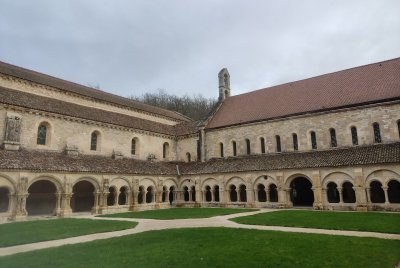
I visited the Fontenay abbey on the 27th of february 2024. I took a train early in the morning to travel from Dijon to Montbard.I had reserved a bicycle with the local tourist office( just outside the railway station in Montbard) beforehand. Since I arrived around 9.45 I had to wait some minutes before they opened the tourist office.Within a few minutes I got a bike and was on my way to the abbey. I took me around 25 min to reach the abbey which is open-daily-from 10.00-12.00 and from 14.00-17.00 in the winter months from novembre till march. From the end of march on the abbey is open from 10.00 till 18.00.
The old Abbey of Fontenay (12th century) was one of the first monuments to be inscribed on the Unesco world heritage list.It consists of a church, a cloister, a refectory, a dormitory, a bakery and a forge.It also has a small but beautiful garden. To my surprise the abbey even had a small prison as it exercised lower legal jurisdiction in its realm.The abbey was founded in 1118 by Saint Bernard and is today the example par excellence of a cistercian abbey.
The cistercian order was created in France during the 12th century and its spiritual movement founded on the simplicity and humbleness of monastic life spread throughout Europe.
All buildings are still in good shape and intact.However,there are almost no furnishings inside the accessible buildings.1-2h are enough to see everything in detail inside …
Keep reading 0 comments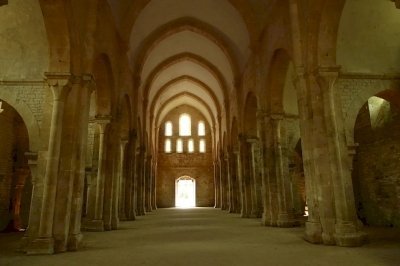
Fontenay is probably the best preserved Cistercian abbey I have visited. As is customary for Cistercian abbeys, it's located along a river valley and you will recognize the usual structures with refractory, chapel and fish ponds. What is missing, are any interior decorations. The abbey was closed during the French revolution and turned into a paper factory for a century thereafter. At the beginning of the 20th century, a rich French banker bought the estate and began the restoration of the site. The family to this day owns the property.
The most similar site I have visited is Maulbronn. The main difference is that Maulbronn is more lively as it has more interiors and decorations left and a small town grew around it.
Getting There
Fontenay is near the town of Montbard. Montbard proudly advertizes the fact that they are a TGV stop. Which is kind of true as the TGV between Djion and Paris stops there a few times a day. Alternatively, there also (slower) regional trains that connect you to both Dijon and Paris. Note: The TGV requires a reservation and is frequently fully booked; I ended up having to take the regional train back to Paris. The train schedules in general (as is the case for most of France) are infrequent and cumbersome.
From the train station, I had to walk as there was no bus connection. It's roughly 6km. Problem is that the best footpath is not on google maps or …
Keep reading 0 comments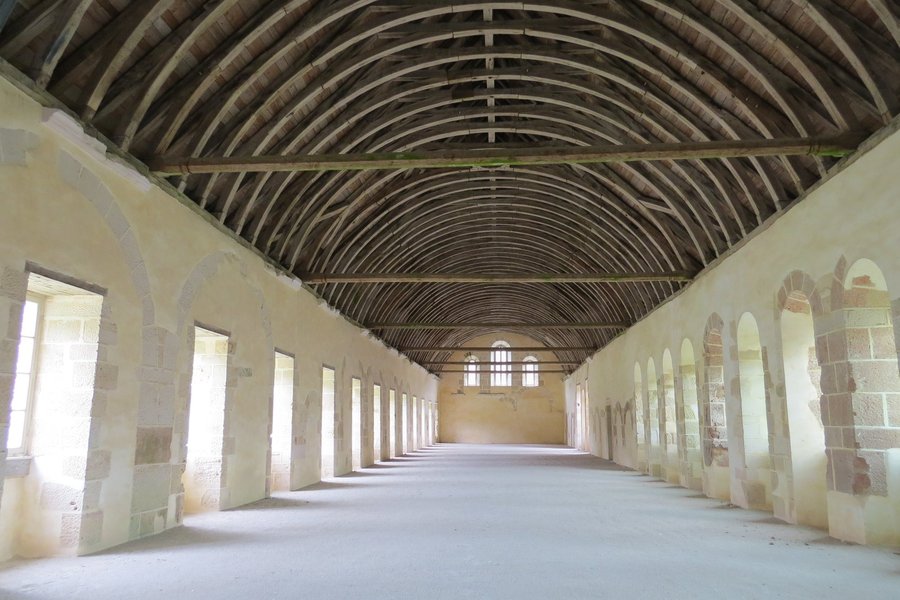
The best maintained/upkept site I have seen but perhaps this is because the site is only opened to paying tourists. It´s history regarding iron handling was interesting as it seems to be a pattern for later iron handling. But we must realized it is all restored and not so much original as many other sites.
Keep reading 0 comments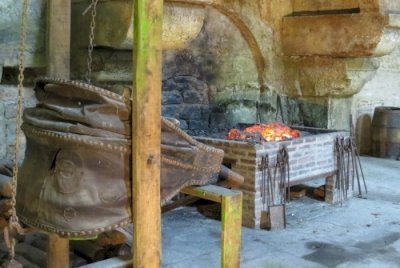
The Cistercian Abbey of Fontenay is a 12th-century former monastery in Burgundy. The Cistercian godfather Saint Bernard of Clairvaux found a sufficiently remote location to create a new community of monks, one of many at that time. The Cistercians broke away from the mainstream Benedictines because they felt that the Benedictine monks had become too worldly and devoted too little time to manual labor. The Cistercians made up for that in self-sufficient communities like this.
The Abbey owes its place on the List to its excellent state of preservation. I visited it by car from Reims on a combined day trip with the WHS of Vézelay. In the year 2015, this still is an off-the-beaten-track location, though the Abbey receives over 100,000 visitors a year. I drove on minor roads for over an hour, passing this region’s typical ramshackle villages that look deserted. Only at the site’s car park I was back among living creatures again. I arrived around 10.30, at the same time as two buses with German tourists. Also I counted some 40 cars with individual visitors.
Access to the site is run professionally. As the Abbey is now in private hands, they rely on the income from tourists to cover the costs of conservation. There’s a 10 EUR entrance fee if you go in by yourself, or 12.5 EUR if you join a guided tour. They hand out brochures in several languages, I received one in Dutch which was informative enough to get to know …
Keep reading 0 comments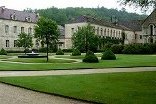
I visited this WHS in July 2013. It is really well kept and quite different from the Maulbronn Abbey in Germany I visited earlier this year. The guide is very informative and explains the site in detail. After the tour I explored the site on my own since all the other tourists headed towards the car park, which meant I had the site all for myself. The cloister and austere chapel are in great condition considering that they are over 1000 years old! Well worth the detour from nearby Vezelay!
Keep reading 0 comments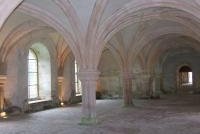
The restoration of this ensemble of buildings has been so carefully carried out that it is hard to believe that they are nearly 1000 years old. The grounds too are kept in pristine condition.
To reach this site I had no alternative but to take a taxi from Montbard station. In between showers of rain I moved from abbey church to cloiser to dormitories to kitchen and workshop, all of which lacked decoration and seemed most austere.
Keep reading 0 comments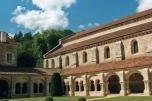
In our trip to France we have visited the Cistercian abbey of Fontenay, founded by St. Bernard in 1119 and built in the small valley of the Engrevies. The church was constructed from 1139 to 1147 by the abbot Guillaume, financed by the bishop of Norwich Ebrard, that is buried here, and consecrated by the Pope Eugene III, a Cistercian and former pupil of St. Bernard. The abbey, restored in 1906, is a Romanesque masterpiece and it’s entirely preserved in this style, apart from the refectory and despite the transformations of the 13th, 15th and 18th centuries and the ruins of the 18th and 19th century. It has a plan in the form of latin cross, a blind nave and a towerless transept and contains only an altar and a statue of Our Lady; near that are the cloister and the chapter house. The architecture is simply and modest and places ashlars side by side with crude rough-cut rubble. There are also many communal buildings within the enclosing wall: the monks’ room, the monks’ dormitory, the council room, the heating room, the abbot’s lodging, the refectory, the infirmary, the guest quarters, the bakery, the hostel, the chapel, the garden, the gate, the dovecote and the forge (12th century), that is one of the oldest industrial buildings in France.
I liked very much this abbey because of its particular and simply architecture. It's worth to be visited if you are in Burgundy but I don't think it justifies the inscription because …
Keep reading 0 comments
